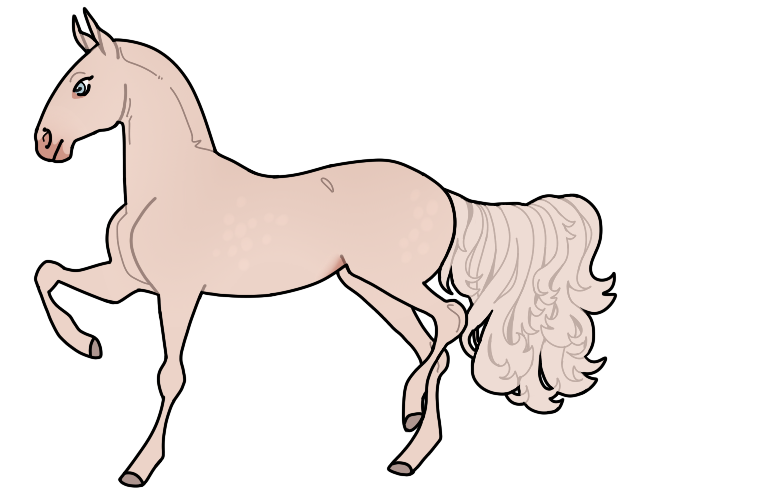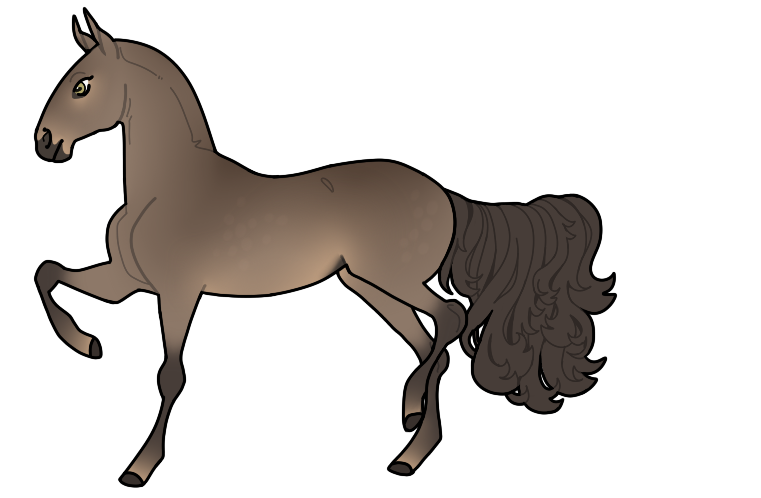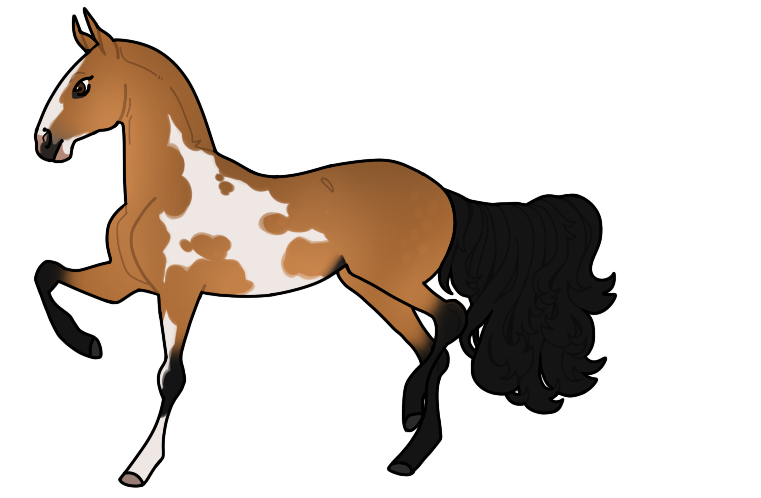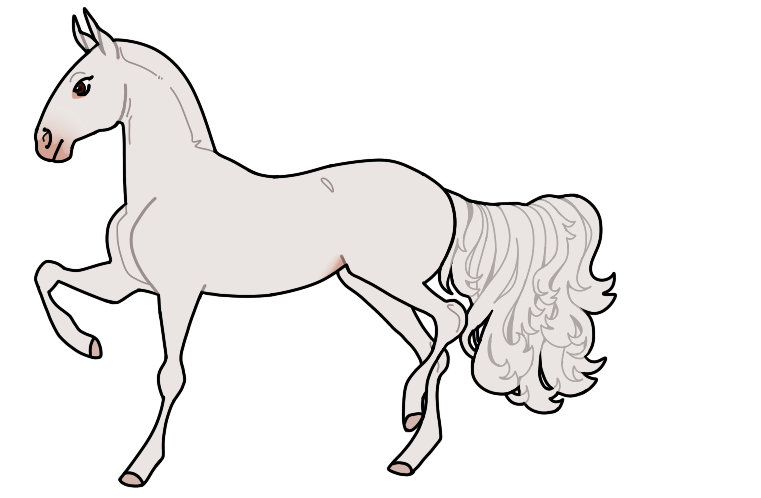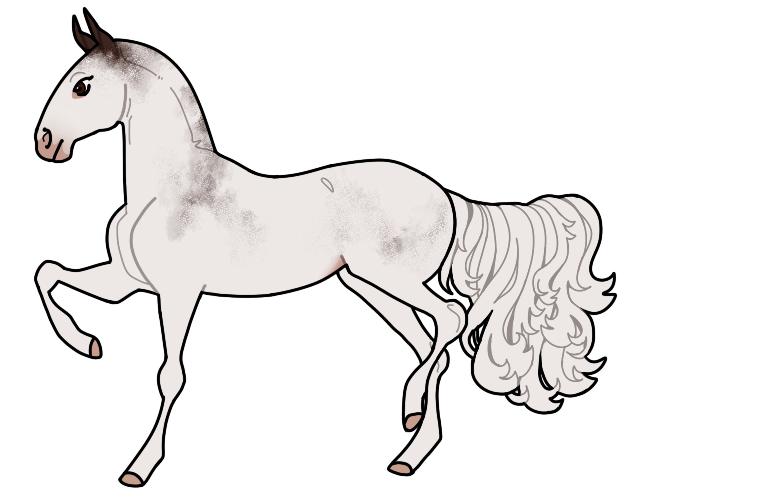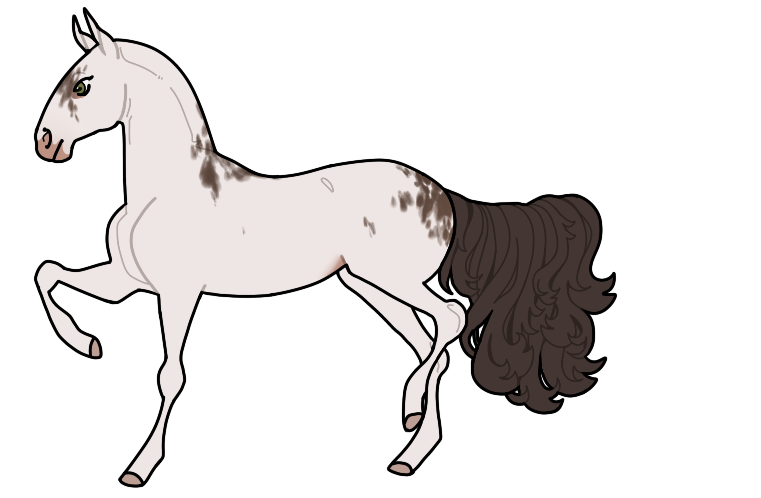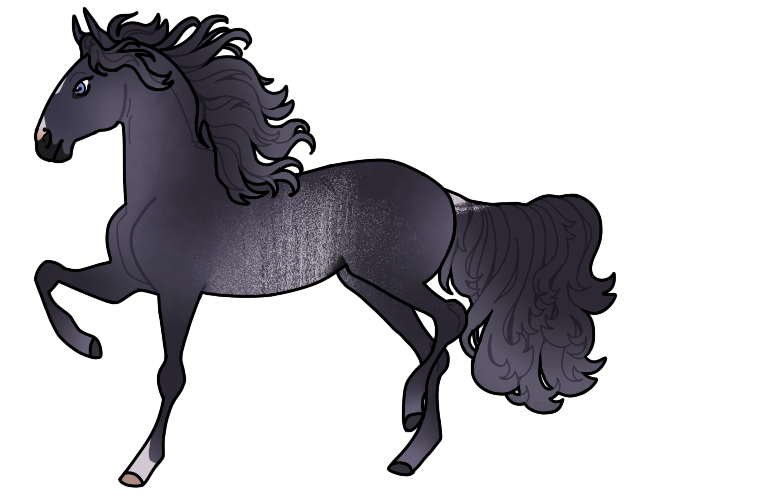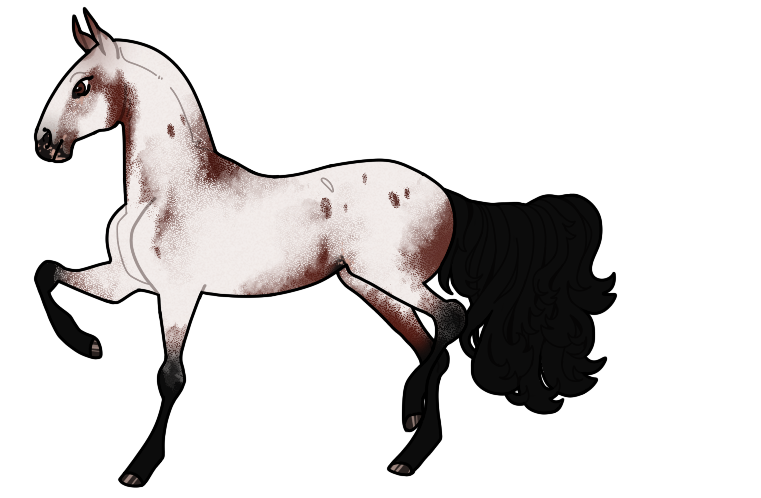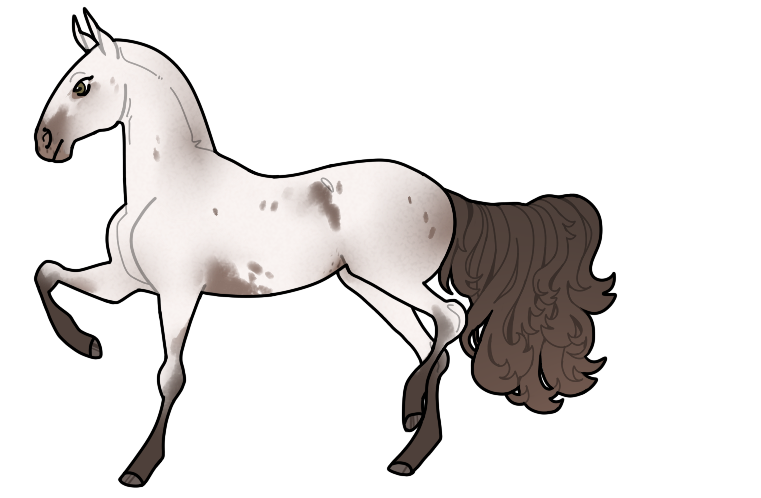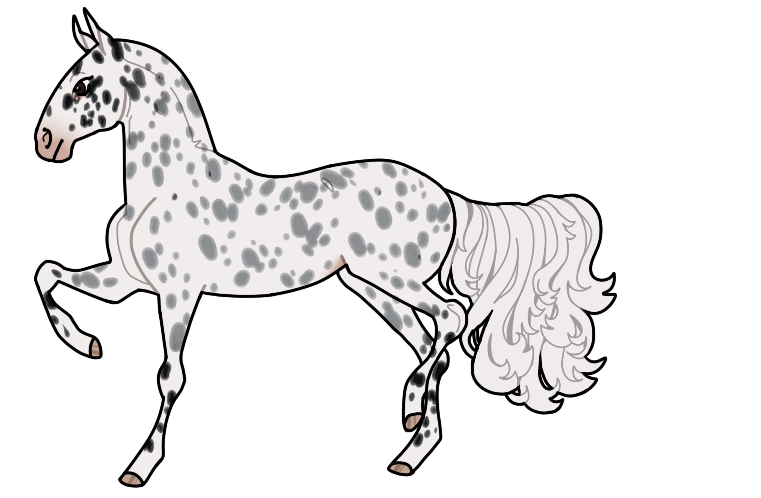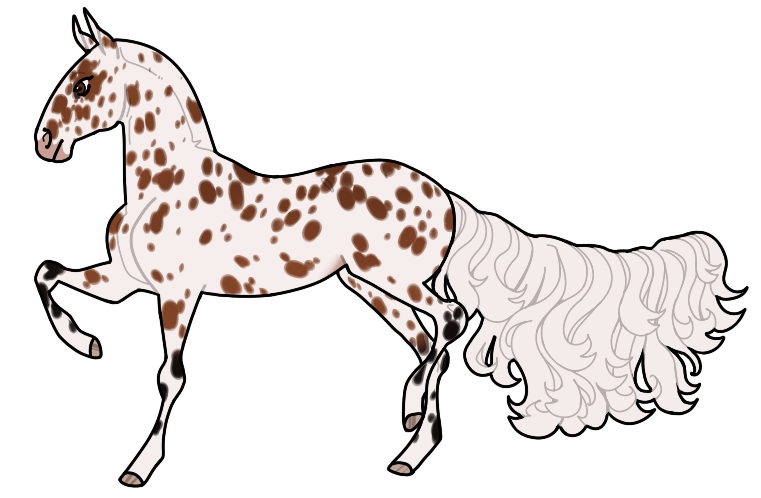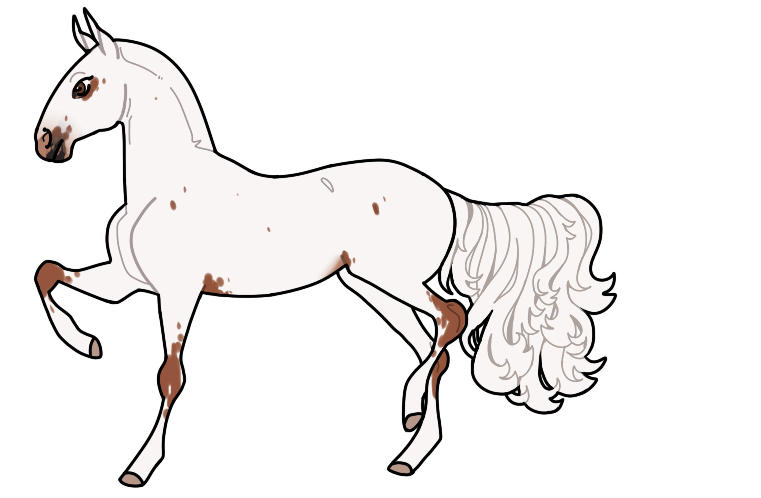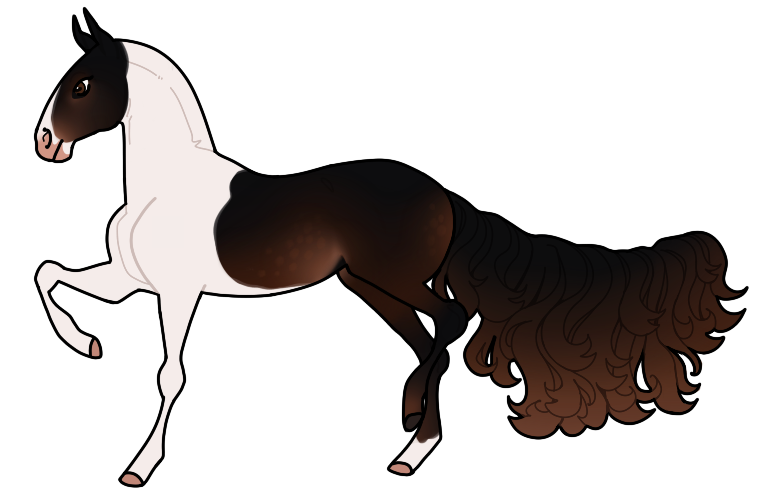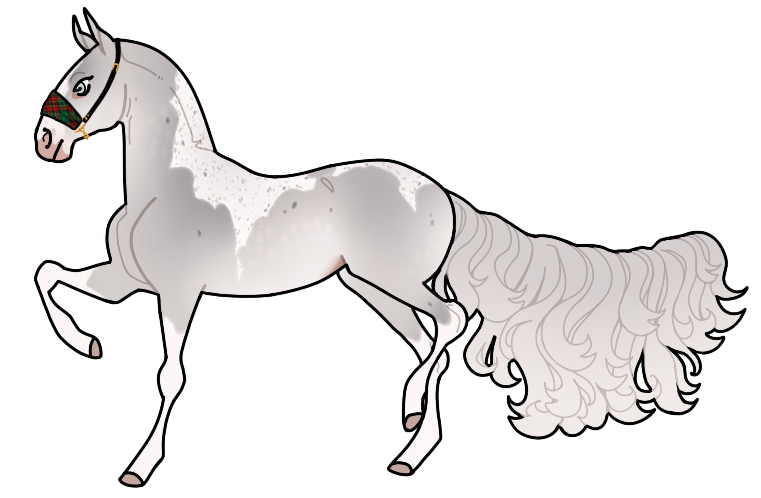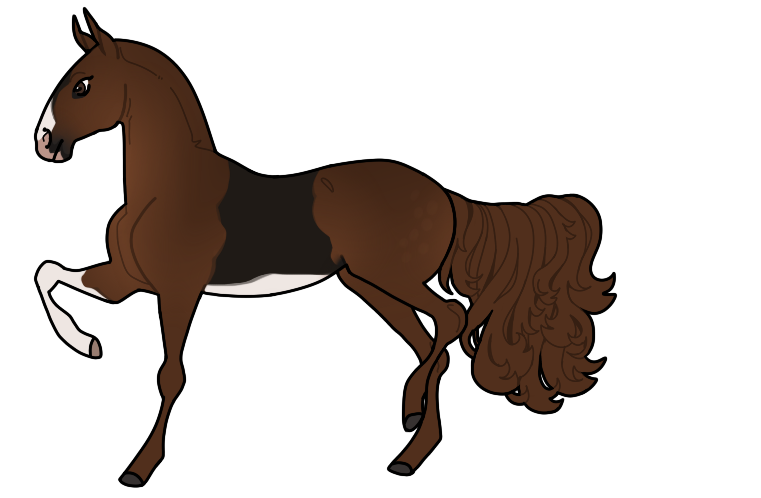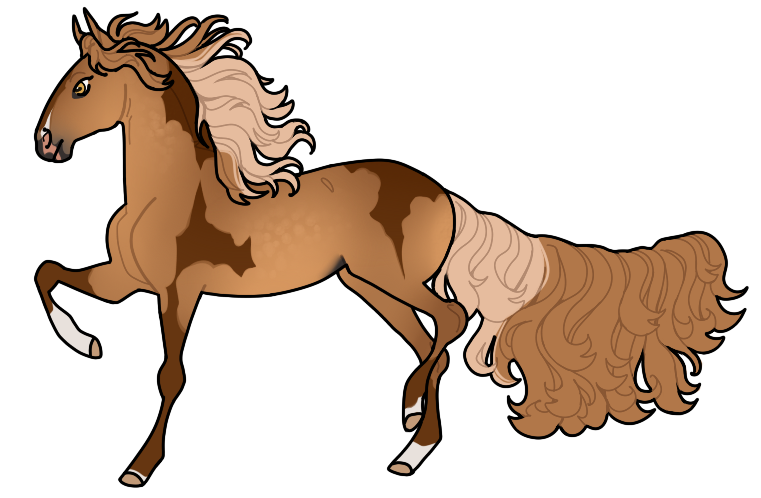Design Guide
Pearl (Rare)
GOLD PEARL
- Genetics: ee __ prlprl
- Skin: Pink or Medium Grey-Pink
- Eyes: Green/Hazel | Detail Guide
- Lightens the coat to a creamy/gold shade, with mane and tail light cream or white.
- Tends to be a little darker than Gold Champagne, with a slightly warmer tone.
BAY PEARL
- Genetics: E_ A_ prlprl
- Skin: Pink or Medium Grey-Pink
- Eyes: Green/Hazel | Detail Guide
- Lightens the coat to a creamy/gold shade, with legs and mane/tail a darker brown color.
- Tends to be a little darker than Amber Champagne, with a slightly warmer/muted tone.
BLACK PEARL
- Genetics: E_ aa prlprl
- Skin: Pink or Medium Grey-Pink
- Eyes: Green/Hazel | Detail Guide
- Lightens the coat to a greyish-brown, with legs and mane/tail slightly darker.
- Tends to be a little darker than Classic Champagne, with a slightly warmer tone.
Double Cream (Rare)
CREMELLO
- Genetics: ee __ CrCr
- Skin: Pink
- Eyes: Blue | Detail Guide
- Light cream body; should not be white, but should be very pale.
- Mane/tail are either lighter/white or the same color as the body.
PERLINO
- Genetics: E_ A_ CrCr
- Skin: Pink
- Eyes: Blue | Detail Guide
- Light cream body; should not be white, but should be very pale. Same range as Cremello.
- Mane/tail are a slightly darker, reddish-orange shade. Should not be very saturated.
- Legs are often slightly lighter and less saturated than the mane/tail.
SMOKY CREAM
- Genetics: E_ aa CrCr
- Skin: Pink
- Eyes: Blue | Detail Guide
- Light cream body; should not be white, but should be very pale.
- Mane/tail are either slightly darker or the same color as the body.
- Should appear similar to Cremello, but a little darker/more "burnt" shade.
Fraiche (Rare)
GINGER
- Genetics: ee __ Fr_
- Skin: Medium/Dark Grey
- Eyes: Gold-Yellow, Yellow-Green, or Blue | Detail Guide
- Causes a golden/orange coat; somewhat similar to Gold Pearl, but darker/more saturated.
- Should have noticeable countershading on the topline and knees/hocks.
- Tail should be slightly lighter than the topline.
SPICE
- Genetics: E_ A_ Fr_
- Skin: Medium/Dark Grey
- Eyes: Gold-Yellow, Yellow-Green, or Blue | Detail Guide
- Causes a desaturated light/medium-brown coat.
- Should have blended tan pigment around the muzzle, eyes, groin, and coronets.
- Should have noticeable darker countershading along the back.
- Legs and tail should be a darker grey-brown, except for the coronets (tan).
SLATE
- Genetics: E_ aa Fr_
- Skin: Medium/Dark Grey
- Eyes: Gold-Yellow, Yellow-Green, or Blue | Detail Guide
- Causes a blueish-grey coat with lightened coronets.
- Mane and tail should be slightly lighter than the base.
- Should not be overly saturated, but will be a little bit bluer than other coats.
Plum (Rare)
CHESTNUT PLUM
- Genetics: ee __ plmplm
- Skin: Medium/Dark Grey
- Eyes: Gold-Yellow, Purple, or Brown | Detail Guide
- Similar to normal Chestnut, but with a reddish-purple tint.
- Causes lightening around the eyes, muzzle, withers, groin, coronets, and hindquarters.
- Mane/tail should be darker than the back on all three of these bases.
BAY PLUM
- Genetics: E_ A_ plmplm
- Skin: Medium/Dark Grey
- Eyes: Gold-Yellow, Purple, or Brown | Detail Guide
- Similar to normal Bay, but with a reddish-purple tint.
- Causes lightening around the eyes, muzzle, withers, groin, coronets, and hindquarters.
- Mane/tail should be darker than the back on all three of these bases.
- Exhibits dark points up to the knee/hock, matching the mane/tail.
BLACK PLUM
- Genetics: E_ aa plmplm
- Skin: Medium/Dark Grey
- Eyes: Gold-Yellow, Purple, or Brown | Detail Guide
- Similar to normal Black, but with a reddish-purple tint.
- Causes lightening around the eyes, muzzle, withers, groin, coronets, and hindquarters.
- Mane/tail should be darker than the back on all three of these bases.
Berry (Rare)
RASPBERRY
- Genetics: ee __ Br_
- Skin: Medium/Dark Grey
- Eyes: Blue or Purple | Detail Guide
- Body and topline is a soft purple tone, with reddish undertones around the face, chest, and belly.
- Legs are slightly darker purple, with light blending around the coronets/pasterns.
- Tail should be reddish on top and light purple at the tips.
BLACKBERRY
- Genetics: E_ A_ Br_
- Skin: Medium/Dark Grey
- Eyes: Blue or Purple | Detail Guide
- Body and topline is a darker purple, with reddish undertones around the face, chest, and belly.
- Legs should have dark grey/near-black points up to the knee/hock.
- Tail should be the same color as the legs on top and blend out to blue OR reddish/purple at the tips.
BLUEBERRY
- Genetics: E_ aa Br_
- Skin: Medium/Dark Grey
- Eyes: Blue or Purple | Detail Guide
- Body is blue-grey, with a darker topline and lighter undertones around the face, chest, and belly.
- Blended darkening around the coronets/pasterns.
- Tail should be the same color as the topline on top and fade to lighter blue.
Sabino (Rare)
Genetics: Sb_
Locus: Sb
Overview:
- Causes irregular white patterning that starts from the underside of the horse.
- May have jagged/irregular edges or be textured/powdery at the edges.
- Can cause extensive and/or irregular face markings, including "badger face," but will not make eyes blue.
- Mane/Tail: White where marking is touching.
- Skin: Pink skin beneath white markings.
- Eyes: No effect
Interactions:
- Sabino may cause the edges of other white markings to be irregular/textured as well.
Range:
- Minimum: May be fully hidden if desired.
- Maximum: Must clearly come from the underside of the horse and should leave most of the topline uncrossed.
Overo (Rare)
Genetics: O_
Locus: O
Lethal White Syndrome occurs for "OO" Overo horses, and is fatal. If a foal geno is rolled as OO, it will be marked unusable. With this in mind, it is possible for a breeding to fail completely if two LWS foals are rolled, and the slots will still be used up if this occurs.
Overview:
- Causes irregular white patterning that starts from the belly and/or center of the horse. Markings should have cutouts around the edges to cause irregularity of shape and sharp edges. Will not round outward.
- White generally spreads within the center area of the horse, creating a "frame" of color around it. The only areas on the body where it may cross to the other side of the horse are the crest of the neck and the belly (from behind armpit to just past groin).
- Can cause extensive and/or irregular face markings, generally bald faces with some cutouts. May cause badger face.
- Mane/Tail: White in mane where touching; will not affect tail, as it cannot cross/touch.
- Skin: Pink skin beneath white markings.
- Eyes: Blue (optional)
Range:
- Minimum: May be fully hidden if desired.
- Maximum: White markings on the vast majority of the body, not crossing the "frame" of the body except on the neck/belly. Significant white markings on the face and legs.
Dominant White (Rare)
Genetics: W_
Locus: W
Lethal White Syndrome occurs for "WW" Dominant White horses, and is fatal. If a foal geno is rolled as WW, it will be marked unusable. With this in mind, it is possible for a breeding to fail completely if two LWS foals are rolled, and the slots will still be used up if this occurs.
Overview:
- White marking with extensive coverage., often making the entire body pure white.
- If incomplete, edges should be textured - may be jagged or powdery, similar to Sabino.
- Mane/Tail: White where touching.
- Skin: Pink skin beneath white markings.
- Eyes: No effect
Range:
- Minimum: Similar to high-coverage Sabino. Should have white markings across at least 50% of the barrel/neck (scattered, not just a perfect split), high leg white (at or above knee/hock), and extensive face white.
- Maximum: Body, mane, and tail are completely white.
Rabicano (Rare)
Genetics: Rb_
Locus: Rb
Overview:
- Causes vertically-oriented white markings that originate at the flank. Should not be horizontal or patchy/solid.
- Markings should be speckly/roany/stripey, but should not resemble Brindle or Sabino.
- Mane/Tail: Tail must have either gradiented white at the root, or "skunk tail" (ribbed/striped white at the root; see examples).
- Skin: Pink speckling/mottling (optional)
- Eyes: No effect
Range:
- Minimum: Some expression at the groin only; must be noticeable, around the size of the hoof at minimum.
- Maximum: Vertical coverage that does not cross/touch topline. Horizonal coverage to armpit and first third of hindquarters.
Varnish Roan Appaloosa (Rare)
Genetics: LpLp
Locus: Lp | Modified by patn
nLp = Snowflake Appaloosa, nLp patn = Blanket Appaloosa, nLp patnpatn = Leopard Appaloosa
LpLp patn = Snowcap Appaloosa, LpLp = Varnish Roan, LpLp patnpatn = Fewspot Appaloosa
Overview:
- Creates an irregular roan-like expression, often with some spots/holes and large blended sections taken out.
- Typically extends on to the face, unlike typical roan, and is patchy in the most bony areas (hips, withers, joints, face, etc). Patches should be textured/powdery.
- Can also exhibit spotting (holes in the pattern), though this should be kept sparse and should not appear Leopard-like.
- Please note that Varnish Roan is considered a white marking, and therefore should be white rather than low-opacity like normal roan. The pattern should appear as a white marking and not just an overlay.
- Mane/Tail: No effect
- Skin: Pink skin beneath white markings, optional pink mottling on unaffected skin.
- Hooves: Optional tan/shell striping.
- Eyes: No effect
Range:
- Minimum: Covers the body and neck, leaving the head and legs alone.
- Maximum: Covers everything except the lower legs.
Leopard Appaloosa (Rare)
Genetics: nLp patnpatn
Locus: Lp | Modified by patn
nLp = Snowflake Appaloosa, nLp patn = Blanket Appaloosa, nLp patnpatn = Leopard Appaloosa
LpLp patn = Snowcap Appaloosa, LpLp = Varnish Roan, LpLp patnpatn = Fewspot Appaloosa
Overview:
- Makes the coat white, with spots of the base color all over the body.
- Size of spots should generally be around eye to hoof sized, and should not be too sparse.
- Spots should generally be somewhat oblong. Can range in amount of spots, from light to very heavy.
- Spots should be present on all parts of the body, including head and legs.
- Mane/Tail: Mane will be white with streaks where spots touch. White or optionally streaked tail.
- Skin: Pink skin beneath white markings, optional pink mottling on unaffected skin.
- Hooves: Optional tan/shell striping.
- Eyes: No effect
Fewspot Appaloosa (Rare)
Genetics: LpLp patnpatn
Locus: Lp | Modified by patn
nLp = Snowflake Appaloosa, nLp patn = Blanket Appaloosa, nLp patnpatn = Leopard Appaloosa
LpLp patn = Snowcap Appaloosa, LpLp = Varnish Roan, LpLp patnpatn = Fewspot Appaloosa
Overview:
- Makes the coat white, with patches of color at the armpit/groin (required) and optionally the knee/hock, eyes, and muzzle.
- A few small spots of base color are strewn across the coat, around eye-sized or smaller. Spots should be sparse.
- Mane/Tail: White, with optional streaks (must be minimal/few).
- Skin: Pink skin beneath white markings, optional pink mottling on unaffected skin.
- Hooves: Optional tan/shell striping.
- Eyes: No effect
Rapunzel (Rare)
Genetics: rp_
* Must be homozygous to show; otherwise carried
Locus: rp
Overview:
- This mutation does not affect the coat, only the tailbone length.
- For more details, please see our Tail Tutorial page!
Patchwork (Rare)
Overview:
- Causes the secondary phenotype to display in the areas where all white markings would be.
- On foals, Patchwork may be anything genetically possible from the parents. In breedings, it is automatically rolled for color.
- On imports, Patchwork is based on the main phenotype. You may remove genes found in the base geno, switch the base color (e/a genes), and add up to 1 natural marking/modifier.
- Rapunzel, carried genes, and oddities are not listed in the Patchwork phenotype.
- Coverage is determined by how much white the horse would have, rather than being subject to normal Chimera rules.
- The base coat will not have white markings, but the Patchwork coat may have white markings and show them that way.
- Affects everything listed under "White Markings" on the Visual Hierarchy page.
- Chimera and Patchwork cannot be on the same horse.
Interactions:
- Oddities* found on the base coat may also show on the Patchwork coat without being in the Patchwork pheno.
- *This excludes Chimera/Patchwork itself - no Patchwork-ception, sorry!
- Marbled: When paired with Patchwork, Marbled will be present around the Patchwork areas as if it were still a white marking.



